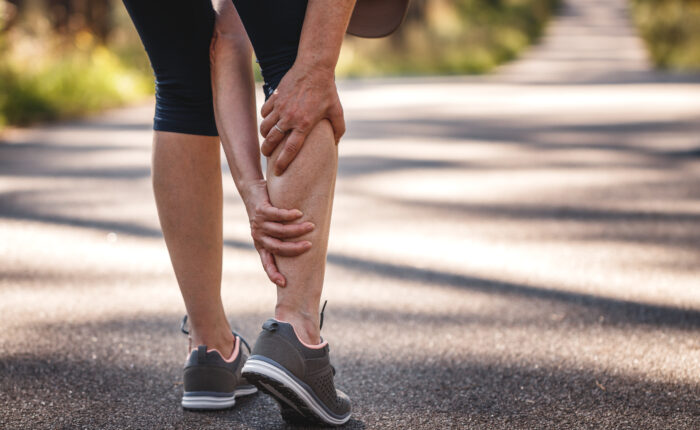As athletes and fitness enthusiasts know, the satisfaction of a good run or workout is well worth the training and energy you devote to it, although not every part of your activity always comes naturally. Exercise-associated muscle cramps (EAMCs) represent one of those moments where your body suddenly rebels against your routine, turning what was a smooth run into a grueling struggle.
Though nearly every runner has encountered these unexpected cramps, understanding them better can pave the way toward mitigating their impact and improving your overall running experience.
Symptoms of running cramps
Running cramps come in various forms, often catching runners off-guard with how suddenly and unexpectedly they arise. Medically speaking, cramps are involuntary muscle contractions that cause intense discomfort or pain, which forces many eager athletes to slow down or halt their activity entirely. Two of the most recognizable symptoms include cramping in calves and the notorious side stitch.
Calf cramping can quite literally stop you in your tracks. This type of cramping manifests as a severe tightening in the calf muscles, often feeling like an internal knot that’s impossible to untangle.
The side stitch, meanwhile, is a sharp, stabbing pain experienced on either side of the abdomen, often just below the ribs. Some side stitches are not painful enough to stop the workout, but others can be debilitating and deeply uncomfortable for several minutes.
Both of these kinds of cramps can disrupt focus, alter breathing patterns, and break the rhythm you’re in, especially when it happens during a race or game. While side stitches can sometimes be managed through breath control and posture adjustments, calf cramps often necessitate rest, stretching, and hydration to release the vice-like grip on the muscle.
What causes muscle cramps?
Muscle cramps are a sudden, temporary, and involuntary contraction of muscles that can occur not only when exercising, but also throughout everyday life. Cramping is largely unpredictable, which means there isn’t a ton of reliable research on how to solve the condition, and since it can be caused by a number of things, there are also a number of potential solutions we can’t say for certain will work for your specific experience.
Although the research on what causes different types of cramps is hard to come by, dehydration and electrolyte imbalance often rank high on the list of potential causes. During intense physical exertion, loss of fluids and salts through sweat can lead muscles to contract involuntarily.
Another factor that the research doesn’t fully support, but athletes and people of all kinds generally accept, is inadequate warm-up or stretching before a run. Muscles that are not prepared for the elevated demands of running can become fatigued, leading to the sudden onset of cramps.
Additionally, poor circulation or inadequate blood supply to the muscles likely increase the risk of cramping, as can running on uneven surfaces, which may strain certain muscle groups more than others.
Lastly, overexertion and activities that go beyond one’s current fitness levels also seem to increase the risk of cramping, as muscles become fatigued and quickly reach their breaking point.
Preventing muscle cramps when running
Before we get into a few potential cramp remedies, it’s important to note that cramps may continue happening to you no matter what you try based on internet research. A more effective solution likely lies in getting a professional evaluation from an athletic trainer or even a physical therapist. We know this may seem like too much if you’re just a casual jogger, but it does provide the most reliable advice not only for preventing cramps, but other injuries and conditions as well.
Warm up with light exercise
An effective warm-up routine, designed to gradually increase heart rate and prep the muscles for exercise, can be one of the simplest, most impactful changes a runner can implement. A thoughtfully tailored warm-up—perhaps a combination of dynamic stretching and light jogging—ensures that your muscles are adequately primed for your run.
Avoid common cramp triggers
A second strategy is to deepen your understanding of your own body and fitness level. Different runners may experience cramps for different reasons, and identifying personal triggers can help prevent future occurrences. Pay attention to what you eat and when, how you hydrate, and how your body reacts to different terrains or running speeds. Knowledge of these factors allows you to tailor your routine and avoid the situations that might increase your personal cramping risks.
Watch hydration and mineral balance
Proper hydration when running is essential, but it’s important to recognize the distinction between simply drinking water and replenishing the water and electrolytes you lose when you sweat. Especially during long or really hot runs, an abundance of plain water might dilute the body’s electrolyte levels, making the root of cramping issues worse.
Electrolytes—mainly sodium, potassium, and magnesium—collaboratively maintain muscle function and fluid balance. Electrolyte-rich drinks, when consumed before, during, and after prolonged exercise, can help replenish the right balance of both water and minerals lost to sweat.
Timing and quantity of fluid intake can also contribute to worse cramping. A common recommendation is to hydrate consistently throughout the day—not just around the time of exercise—to allow the body to maintain its equilibrium at every level of activity.
Improve general fitness condition
Finally, implementing strength training and cross-training exercises is another potential way to reduce cramps when running. Simply put, better-conditioned athletes tend to experience fewer cramps as their bodies adapt over time to the demands of endurance runs.
When running, your body doesn’t just need strong calves and quads, but also solid core and back muscles. Strengthening these supportive muscle groups not only enhances your overall physical condition but also actively prevents muscle fatigue. Additionally, by mixing up your routine with other exercises like cycling, swimming, or yoga, you’re providing your muscles with the versatility to handle the overall demands of running better.
A comprehensive fitness routine should also factor in rest days to allow ample time for recovery. Allow your body to recuperate from performance exercise with time and good nutrition so it can gradually build its capacity to handle greater physical exertion. Doing too much too quickly can lead to fatigue and a lack of healing, which makes it important to pace yourself according to your fitness ability.
Personalized running cramp solutions and training
At Sol Physical Therapy, our physical therapists and trainers are runners and athletes, meaning we know what is and isn’t normal for nearly any activity during which you experience cramps. Our specialists can listen to your concerns and quickly get you on track to reduce muscle cramps when working out or playing, and give you expert advice on how to prevent them from happening in the future. Get a conversation started with our team by calling one of our nearby office locations or requesting your appointment online today.


